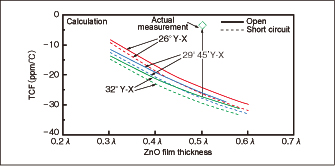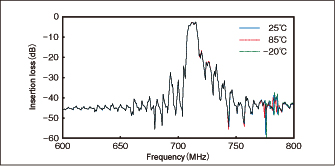Highly Coupled ZnO/Quartz Structure Surface Acoustic Wave Device with Good Temperature Characteristics
Looking into the value of the electrode width which can be made actually based on these studied results, in order to design a desired appropriate filter, electrodes should be Au in the range of around the metallization ratio of 0.3, having the electrode film thickness around 0.02 to 0.03λ. As previously mentioned, this device uses a ZnO film with a thickness of 0.5λ in order to have a larger value of k2. Further, the research team changed the electrode material to Au from Al, making it necessary to optimize the cut angle of quartz to have the TCF≒0. A ZnO film has a negative TCF thereby necessitating the selection of a quartz substrate with a positive TCF angle. Figure 6 shows TCF values of a ZnO/Au-electrode/quartz resonator filter with various cut angles at the temperatures between 25 and 85℃. There was a variance between the measured value and the calculated value, probably due to the difference existing in the material constant of a ZnO single crystal used in the calculation compared with an actual ZnO thin film. This phenomenon is supported by a report that the thicker the ZnO film becomes, the greater the difference between the theoretical value and the measured value becomes. Figure 6 shows that a quartz with a cut angle range which became lower improved a TCF. By taking into account the variance from the measured value, it is possible to presume that the TCF can be brought to zero proximity with the use of a thicker ZnO film.
Fig. 6 TCF's ZnO film thickness dependence in a quartz with various cut angles (Calculated value by Campbell & Jones method)

Based on the above data, the research team designed an RF filter for MediaFLOTM having the center frequency of 719MHz and the pass bandwidth of 5MHz. This was in a one stage structure of a longitudinally-coupled multi-mode resonator type where the ZnO film thickness was 0.48λ, the Au electrode thickness 0.027λ, the metallization ratio 0.3, and the cut angle of the quartz 29º45'Y-X. In this case, the wavelength λ was 3.69µm. The filter comprised two IDTs and two reflectors. Figure 7 shows the measured pass characteristics of the filter. The research team achieved the minimum loss of 2.65dB at 712.1MHz, and bandwidth of 1.03% in 3dB from the center frequency level, a sufficient bandwidth for MediaFLOTM. The TCF was functioning well in that the research team was able to achieve the center frequency change of 101ppm (+0.96ppm/℃ of TCF effectively) and TCF≒0 in the range between -20 and +85 ℃.
Fig. 7 Pass characteristics of a filter for MediaFLOTM using a ZnO/Au-electrode/29º45'Y-X quartz structure
